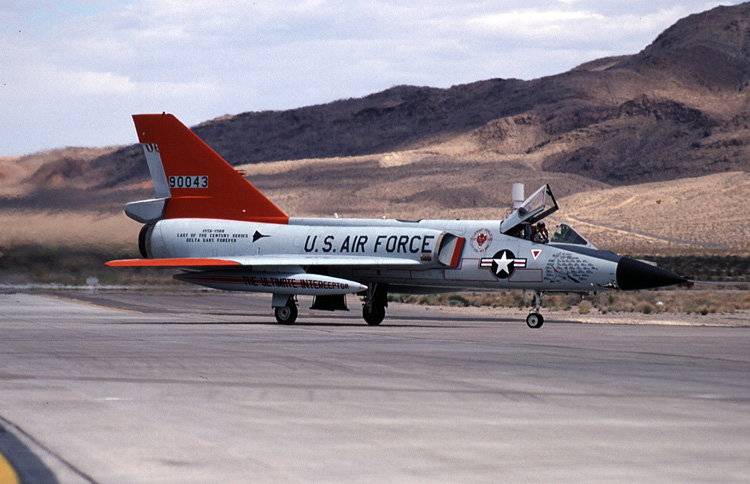|
The Convair F-106A Delta Dart was the primary all-weather
interceptor aircraft for the United States Air Force from the
1960s through the 1980s. Designed as the so-called "Ultimate
Interceptor," it has proved to be the last dedicated interceptor
in USAF service to date. It was gradually retired during the
1980s, although the QF-106 drone conversions of the aircraft
were used until
The F-106 emerged from the USAF's 1954 interceptor program of
the early 1950s as an advanced derivative of the F-102 Delta
Dagger known as the F-102B, with which the United States Air
Force placed an order for in November 1955. The aircraft
featured so many modifications and design changes that it
basically became a new design in its own right, redesignated the
F-106 on 17 June 1956.
.
The F-106 was equipped with the Hughes MA-1
integrated fire-control system, which could be linked to the
Semi-Automatic Ground Environment network for ground control
interception missions (allowing the aircraft to be steered by
ground controllers). It was armed with four Hughes AIM-4 Falcon
air-to-air missiles in its internal weapons bay along with a
single GAR-11/AIM-26A Falcon nuclear-tipped, semi-active, radar
homing missile, or an 1.5 kiloton MB-2/AIR-2 Genie air-to-air
nuclear rocket intended to be fired into enemy bomber
formations. The MA-1 fire-control system proved extremely
troublesome, and was eventually upgraded more than 60 times in
service.

The F-106 served in the continental USA, Alaska, Iceland as well
as for brief periods in Germany and South Korea. In service, the
F-106's official name, "Delta Dart," was rarely used, and the
aircraft was universally known simply as the "Six."
Although contemplated for use in Vietnam, it never saw combat,
nor was it exported to foreign users. After its initial teething
problems were resolved, its exceptional performance made it very
popular with its pilots
Some F-106As were upgraded in Project Six Shooter in 1972,
fitted with a new bubble canopy without the metal bracing along
the top (which greatly improved pilot visibility), an optical
gun sight, and provision for a single M61 Vulcan 20mm cannon
with 650 rounds of ammunition in the weapons bay, replacing the
AIM-26 Super-Falcon or the AIR-2 Genie nuclear rocket.
The F-15A started replacing the F-106 in 1981, with the "Sixes"
typically passed on to Air National Guard units. The F-106
remained in service in various USAF and ANG units until 1988.
Starting in 1986, many of the surviving aircraft were converted
into drones, designated QF-106A, and used for target practice.
The last was destroyed in January 1998. The drones were still
capable of being flown by people, such as for ferrying to a
test; during the test they were flown unmanned. A handful of
F-106s like F-106 58-0780 on the picture left were retained by NASA for test purposes through 1998.
|